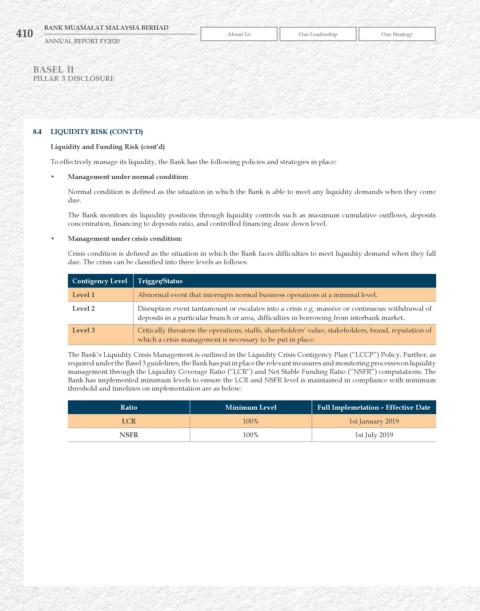Page 412 - Bank-Muamalat-AR2020
P. 412
410 BANK MUAMALAT MALAYSIA BERHAD About Us Our Leadership Our Strategy
ANNUAL REPORT FY2020
BASEL II
PILLAr 3 DISCLOSurE
8.4 LIquIDITy rISk (CONT’D)
Liquidity and Funding risk (cont’d)
To effectively manage its liquidity, the Bank has the following policies and strategies in place:
• Management under normal condition:
Normal condition is defined as the situation in which the Bank is able to meet any liquidity demands when they come
due.
The Bank monitors its liquidity positions through liquidity controls such as maximum cumulative outflows, deposits
concentration, financing to deposits ratio, and controlled financing draw down level.
• Management under crisis condition:
Crisis condition is defined as the situation in which the Bank faces difficulties to meet liquidity demand when they fall
due. The crisis can be classified into three levels as follows:
Contigency Level Trigger/Status
Level 1 Abnormal event that interrupts normal business operations at a minimal level.
Level 2 Disruption event tantamount or escalates into a crisis e.g. massive or continuous withdrawal of
deposits in a particular branch or area, difficulties in borrowing from interbank market.
Level 3 Critically threatens the operations, staffs, shareholders’ value, stakeholders, brand, reputation of
which a crisis management is necessary to be put in place.
The Bank’s Liquidity Crisis Management is outlined in the Liquidity Crisis Contigency Plan (“LCCP”) Policy. Further, as
required under the Basel 3 guidelines, the Bank has put in place the relevant measures and monitoring processes on liquidity
management through the Liquidity Coverage Ratio (“LCR”) and Net Stable Funding Ratio (“NSFR”) computations. The
Bank has implemented minimum levels to ensure the LCR and NSFR level is maintained in compliance with minimum
threshold and timelines on implementation are as below:
ratio Minimum Level Full Implemetation – Effective Date
LCr 100% 1st January 2019
NSFr 100% 1st July 2019

